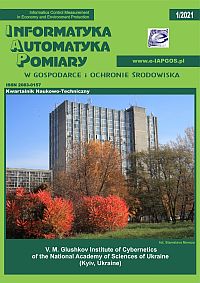Agarwal S.: Symmetric Key Encryption using Iterated Fractal Functions. International Journal of Computer Network and Information Security 9(4)/2019, 1–9.
DOI: https://doi.org/10.5815/ijcnis.2017.04.01
Anisimov A. V., Kulyabko P. P.: Information systems and databases: A textbook for students of the faculty computer science and cybernetics. Kyiv 2017.
Bogdanov A., Khovratovich D., Rechberger D.: Biclique Cryptanalysis of the Full AES. Advances in Cryptology – ASIACRYPT 2011. Lecture Notes in Computer Science 7073. Springer, Berlin 2011.
DOI: https://doi.org/10.1007/978-3-642-25385-0_19
Borecki M.: Risk level analysis in the selected (initial) stage of the project life cycle. Management and production engineering review 11(4)/2020, 104–112.
Borecki M., Ciuba M., Kharchenko Y., Khanas Y.: Main aspects influencing the evaluation of atmospheric overvoltages in high-voltage networks. Bull. Pol. Ac.: Tech 69(1)/ 2021, 1–8.
Buryachok V. L.: The choice of a rational method of generating passwords among many existing. Information security 25(1)/2019, 59–64.
Buryachok V. L.: Generate a password for wireless networks using variable rule of complication. Information protection 21(1)/2019, 52–59.
DOI: https://doi.org/10.18372/2410-7840.21.13547
Hughes J., Cybenko G.: Quantitative Metrics and Risk Assessment: The Three Tenets Model of Cybersecurity. Technology Innovation Management Review 2013, 15–24.
DOI: https://doi.org/10.22215/timreview712
Isa M. A. M., Hashim H., Ab Manan J. L., Adnan S. F. S., Mhmod R.: RF simulator for cryptographic protocol. IEEE International Conference on Control System, Computing and Engineering (ICCSCE), 2014, 518–523.
DOI: https://doi.org/10.1109/ICCSCE.2014.7072773
Josefsson S., Leonard S.: Textual Encodings of PKIX, PKCS, and CMS Structures. Internet Engineering Task Force April 2015.
DOI: https://doi.org/10.17487/RFC7468
Khanas, Y., Borecki, M.: Research on the use of algorithms for matrix transformations for encrypting text information. Security and Privacy 3(6)/2020, 1–13.
DOI: https://doi.org/10.1002/spy2.108
Khanas Y., Ivanciv R., Litvinko S.: The algorithm for minimizing matrices in the given direction of reduction and the rules for their restoration. Visnyk of the National University "Lviv Polytechnic" 882/2017, 12–17.
Khanas Y., Ivanciv R.: Application Mirroring of Matrices to Prevent Excessive Reduction. Perspective technologies and design methods of MEMST (MEMSTECH 2016), Lviv-Polyana 2016, 143–145.
DOI: https://doi.org/10.1109/MEMSTECH.2016.7507535
Krasilenko V. G.: Multifunctional parametric matrix-algebraic models (MAM) of cryptographic transformations (CP) with modular operations and their modeling. 72 NPK – conference materials, Odessa 2017, 123–128.
Krasilenko V. G.: Improvement and modeling of electronic digital signatures of matrix type for textographic documents. Proceedings of the VI International Scientific and Practical Conference "Information Control Systems and Technologies" (IUST-Odessa-2017), Odessa 2017.
Krasylenko V. G., Nikitovich D. V., Yatskovskaya R. O., Yatskovsky V. I.: Simulation of advanced multi-step 2D RSA algorithms for cryptographic transformations and blind electronic digital signature. Information processing systems 1(156)/2019, 92–100.
Leurent G., Peyrin T.: SHA-1 is a Shambles. First Chosen-Prefix Collision on SHA-1 and Application to the PGP Web of Trust. Real World Crypto 2020.
Lobur M. V., Ivantsiv R. D., Kolesnyk K. K., Khanas Y. Y.: Development of an algorithm for reducing matrices depending on their size and content. Scientific and Technical Journal "Instrumentation Technology" 2/2016, 29–31.
Nazarkevich M. A., Dronyuk I. M., Troyan O. A., Tomashchuk T. Yu.: Development of a method of document protection by latent elements based on fractals. Information protection 17(1)/2015, 21–26.
Nikonov V. G., Zobov A. I.: On the possibility of using fractal models in the construction of information security systems. Computational nanotechnology 1/2017, 39–49.
Ortiz S. M., Parra O., Miguel J., Espitia R.: Encryption through the use of fractals. International Journal of Mathematical Analysis 11(21)/2017, 1029–1040.
DOI: https://doi.org/10.12988/ijma.2017.710139
Wenliang Du: Computer Security: A Hands-on Approach. CreateSpace Independent Publishing Platform, 2017.







